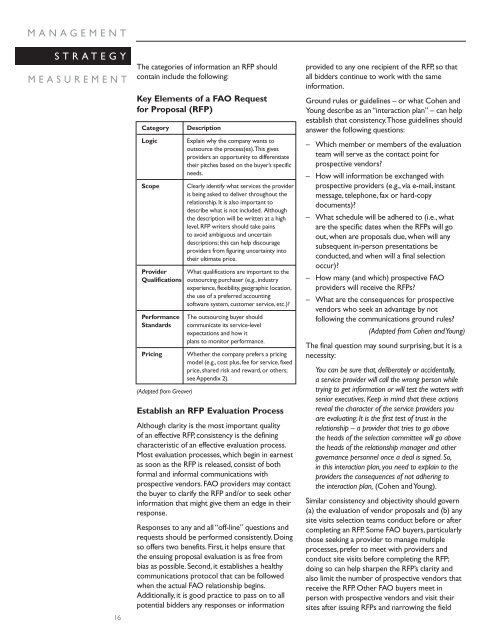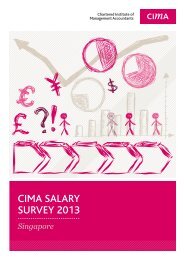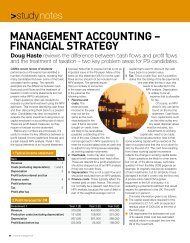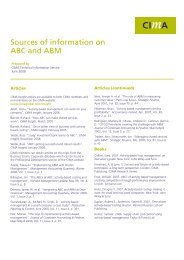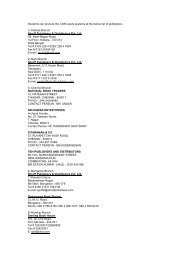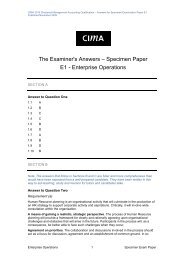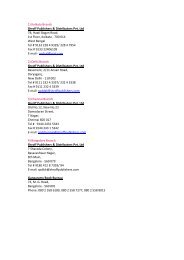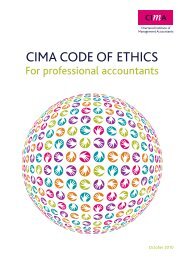Outsourcing the Finance and Accounting Functions - CIMA
Outsourcing the Finance and Accounting Functions - CIMA
Outsourcing the Finance and Accounting Functions - CIMA
Create successful ePaper yourself
Turn your PDF publications into a flip-book with our unique Google optimized e-Paper software.
MANAGEMENT<br />
STRATEGY<br />
MEASUREMENT<br />
16<br />
The categories of information an RFP should<br />
contain include <strong>the</strong> following:<br />
Key Elements of a FAO Request<br />
for Proposal (RFP)<br />
Category Description<br />
Logic Explain why <strong>the</strong> company wants to<br />
outsource <strong>the</strong> process(es).This gives<br />
providers an opportunity to differentiate<br />
<strong>the</strong>ir pitches based on <strong>the</strong> buyer’s specific<br />
needs.<br />
Scope Clearly identify what services <strong>the</strong> provider<br />
is being asked to deliver throughout <strong>the</strong><br />
relationship. It is also important to<br />
describe what is not included. Although<br />
<strong>the</strong> description will be written at a high<br />
level, RFP writers should take pains<br />
to avoid ambiguous <strong>and</strong> uncertain<br />
descriptions; this can help discourage<br />
providers from figuring uncertainty into<br />
<strong>the</strong>ir ultimate price.<br />
Provider What qualifications are important to <strong>the</strong><br />
Qualifications outsourcing purchaser (e.g., industry<br />
experience, flexibility, geographic location,<br />
<strong>the</strong> use of a preferred accounting<br />
software system, customer service, etc.)?<br />
Performance The outsourcing buyer should<br />
St<strong>and</strong>ards communicate its service-level<br />
expectations <strong>and</strong> how it<br />
plans to monitor performance.<br />
Pricing Whe<strong>the</strong>r <strong>the</strong> company prefers a pricing<br />
model (e.g., cost plus, fee for service, fixed<br />
price, shared risk <strong>and</strong> reward, or o<strong>the</strong>rs;<br />
see Appendix 2).<br />
(Adapted from Greaver)<br />
Establish an RFP Evaluation Process<br />
Although clarity is <strong>the</strong> most important quality<br />
of an effective RFP, consistency is <strong>the</strong> defining<br />
characteristic of an effective evaluation process.<br />
Most evaluation processes, which begin in earnest<br />
as soon as <strong>the</strong> RFP is released, consist of both<br />
formal <strong>and</strong> informal communications with<br />
prospective vendors. FAO providers may contact<br />
<strong>the</strong> buyer to clarify <strong>the</strong> RFP <strong>and</strong>/or to seek o<strong>the</strong>r<br />
information that might give <strong>the</strong>m an edge in <strong>the</strong>ir<br />
response.<br />
Responses to any <strong>and</strong> all “off-line” questions <strong>and</strong><br />
requests should be performed consistently. Doing<br />
so offers two benefits. First, it helps ensure that<br />
<strong>the</strong> ensuing proposal evaluation is as free from<br />
bias as possible. Second, it establishes a healthy<br />
communications protocol that can be followed<br />
when <strong>the</strong> actual FAO relationship begins.<br />
Additionally, it is good practice to pass on to all<br />
potential bidders any responses or information<br />
provided to any one recipient of <strong>the</strong> RFP, so that<br />
all bidders continue to work with <strong>the</strong> same<br />
information.<br />
Ground rules or guidelines – or what Cohen <strong>and</strong><br />
Young describe as an “interaction plan” – can help<br />
establish that consistency.Those guidelines should<br />
answer <strong>the</strong> following questions:<br />
– Which member or members of <strong>the</strong> evaluation<br />
team will serve as <strong>the</strong> contact point for<br />
prospective vendors?<br />
– How will information be exchanged with<br />
prospective providers (e.g., via e-mail, instant<br />
message, telephone, fax or hard-copy<br />
documents)?<br />
– What schedule will be adhered to (i.e., what<br />
are <strong>the</strong> specific dates when <strong>the</strong> RFPs will go<br />
out, when are proposals due, when will any<br />
subsequent in-person presentations be<br />
conducted, <strong>and</strong> when will a final selection<br />
occur)?<br />
– How many (<strong>and</strong> which) prospective FAO<br />
providers will receive <strong>the</strong> RFPs?<br />
– What are <strong>the</strong> consequences for prospective<br />
vendors who seek an advantage by not<br />
following <strong>the</strong> communications ground rules?<br />
(Adapted from Cohen <strong>and</strong> Young)<br />
The final question may sound surprising, but it is a<br />
necessity:<br />
You can be sure that, deliberately or accidentally,<br />
a service provider will call <strong>the</strong> wrong person while<br />
trying to get information or will test <strong>the</strong> waters with<br />
senior executives. Keep in mind that <strong>the</strong>se actions<br />
reveal <strong>the</strong> character of <strong>the</strong> service providers you<br />
are evaluating. It is <strong>the</strong> first test of trust in <strong>the</strong><br />
relationship – a provider that tries to go above<br />
<strong>the</strong> heads of <strong>the</strong> selection committee will go above<br />
<strong>the</strong> heads of <strong>the</strong> relationship manager <strong>and</strong> o<strong>the</strong>r<br />
governance personnel once a deal is signed. So,<br />
in this interaction plan, you need to explain to <strong>the</strong><br />
providers <strong>the</strong> consequences of not adhering to<br />
<strong>the</strong> interaction plan, (Cohen <strong>and</strong> Young).<br />
Similar consistency <strong>and</strong> objectivity should govern<br />
(a) <strong>the</strong> evaluation of vendor proposals <strong>and</strong> (b) any<br />
site visits selection teams conduct before or after<br />
completing an RFP. Some FAO buyers, particularly<br />
those seeking a provider to manage multiple<br />
processes, prefer to meet with providers <strong>and</strong><br />
conduct site visits before completing <strong>the</strong> RFP;<br />
doing so can help sharpen <strong>the</strong> RFP’s clarity <strong>and</strong><br />
also limit <strong>the</strong> number of prospective vendors that<br />
receive <strong>the</strong> RFP. O<strong>the</strong>r FAO buyers meet in<br />
person with prospective vendors <strong>and</strong> visit <strong>the</strong>ir<br />
sites after issuing RFPs <strong>and</strong> narrowing <strong>the</strong> field


